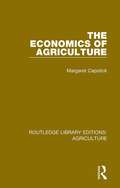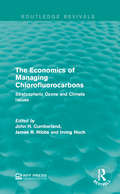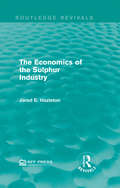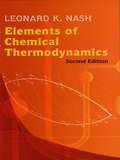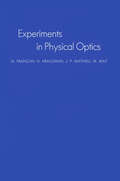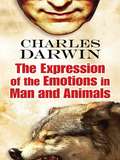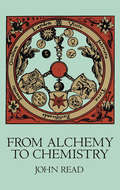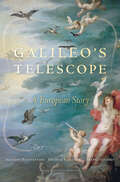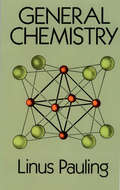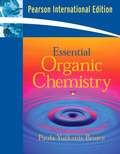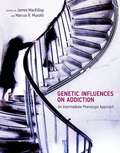- Table View
- List View
Earth Systems, an Earth Science Course
by CurrikiThe Open Source Earth Science course has been organized to meet the CA Science Standards for Earth Sciences in grades 9 - 10, as adopted by the California State Board of Education. This course is part of a set of collections that contain additional Earth Science resources on Curriki that can be accessed at www.curriki.org.
The Economics of Agriculture (Routledge Library Editions: Agriculture #11)
by Margaret CapstickFirst published in 1970. The aim of this book is to provide an introduction to the special problems of agriculture in modern economies. The author writes for students of economics who have already acquired the elements of economic theory; no attempt is made, therefore, to explain simple theoretical concepts, but instead these are used in the analysis of some of the main problems of agricultural adjustment. Emphasis is placed on the position of agriculture in the economies of western Europe and of the United States. Sufficient historical background is given to explain the present use of the factors of production in agriculture and the way in which this use and policies of agricultural support vary from one country to another. Agricultural support policies are discussed with reference to their effect on consumers, producers and on rural society.
The Economics of Managing Chlorofluorocarbons: Stratospheric Ozone and Climate Issues (Routledge Revivals)
by John H. Cumberland, James R. Hibbs and Irving HochChlorofluorocarbons are known to be effective spray can propellants, solvents and refrigerators and were often used in deodorants, refrigerators and other goods. However, it was not known at the beginning of their use, the complex reaction that CFCs have on the earth’s climate. Originally published in 1982, this report explores early research into the effect that CFCs have on the environment and provides guidance on how this emerging issue should be dealt with. This title will be of interest to students of Environmental Studies.
The Economics of the Sulphur Industry (Routledge Revivals)
by Jared E. HazletonBetween the 1950’s and 1970’s, the Sulphur industry continued to grow despite occasional shortages and excesses. In this study originally published in 1970, Hazleton focuses on the Frasch sulphur industry to explore issues such as competing sources of sulphur, the possibilities of sulphur being obtained as a result of pollution-abating policies and the conditions under which future supplies are likely to become available. This title will be of interest to students of Environmental Studies.
Economy Of Machinery And Manufacture #2
by Charles Babbage"...it was my intention to have delivered the present work in the form of a course of lectures at Cambridge; an intention which I was subsequently induced to alter. The substance of a considerable portion of it has, however, appeared among the preliminary chapters of the mechanical part of the Encyclopedia Metropolitana."
Elements of Chemical Thermodynamics: Second Edition (Dover Books on Chemistry)
by Leonard K. NashThis text addresses the use of purely thermal data in calculating the position of equilibrium in a chemical reaction. Its argument highlights the physical content of thermodynamics, as distinct from purely mathematical aspects. Methods are limited to a very few of the most elementary operations of the calculus, all of which are explained in an appendix. Readers need no more than a sound background in high school mathematics and physics, as well as some familiarity with the leading quantitative concepts of an introductory college chemistry course.An introduction establishes the fundamentals of temperature, heat and work, reversibility, and pressure-volume work. The first principle of thermodynamics is explored in terms of energy, enthalpy, thermochemistry and Hess's Law, heat capacity, Kirchhoff's equations, and adiabatic processes. Considerations of the second principle of thermodynamics encompass the Carnot cycle, the concept of entropy, and evaluation of entropy changes. The consequences of thermodynamic principles are examined in chapters on the free energies, the Clapeyron equation, ideal solutions and colligative properties, and the equilibrium state and equilibrium constant. Numerous problems appear throughout the text, in addition to 30 fully worked illustrative examples.
The Endless Crisis: America in the Seventies
by Francois DucheneThe Endless crisis: America in the seventies; a confrontation of the world's leading social scientists on the problems, impact, and global role of the United States in the next decade.
Experiments In Physical Optics
by M. Francon N. Krauzman J.P. Mathieu M. MayExperiments in physical optics for undergraduate and graduate classes. Provides the theoretical basis of each experiment and describes the apparatus required and necessary adjustments. Most of the experiments require only lenses, prisms, mirrors, and polarizers, and can be projected on a lecture screen or viewed by television.
The Expression of the Emotions in Man and Animals (Barnes and Noble Digital Library)
by Charles DarwinIn this highly readable study, one of the great pioneers of modern science examines how people and animals display varieties of emotions via their facial expressions. British naturalist Charles Darwin--who expounded the theory of evolution by natural selection, the principle that launched a scientific revolution—based this survey on his personal observations. Most of his findings were proven by later research, and today's behavioral scientists continue to draw upon this work for both knowledge and inspiration.A bestseller when it was first published in 1872, Darwin's inquiry addresses issues related to human origins and psychology in terms of evolutionary values. His methods include the study of facial expressions in infants and children, the insane, animals, painting and sculpture, and among people in different cultures. Also notable is the fact that this is one of the first books to employ photographs in the interests of science. Abounding in anecdotes and literary quotations, the work offers a direct approach that makes it accessible to professionals and amateurs alike—in fact, to anyone with an inquiring mind.
Fabre, Poet of Science
by Bernard Miall Georges Victor LegrosFabre studied insects, taught about insects, and wrote prolifically about insects. His writing is beautiful and descriptive. He is author of "The Life of the Spider."
The Formation of Vegetable Mould Through The Action of Worms - With Observations on Their Habits
by Charles DarwinFrom Alchemy to Chemistry (Dover Science Books)
by John ReadWritten for the layman, this accessible history takes a broad, humanistic perspective, eschewing chemical equations and formulae. Instead it concentrates on the great figures of chemistry and the ideas that revolutionized the science, from earliest history to the modern era.Much of the book is devoted to alchemy and such topics as the philosopher's stone, alchemical crypticism and symbolism, pseudo-alchemists, Paracelsus, and the "swan song" of alchemy as the scientific revolution took hold. In the final chapters, the author takes up the development of modern chemistry, including atomic theory, the nature of the elements, the beginning of organic chemistry, and more. Broad in scope, erudite yet readable, this rich and absorbing narrative will appeal to anyone interested in the long and colorful history of chemical science. Glossary. 50 illustrations.
Galileo's Telescope: A European Story
by Massimo BucciantiniBetween 1608 and 1610 the canopy of the night sky changed forever, ripped open by an object created almost by accident: a cylinder with lenses at both ends. Galileo's Telescope tells the story of how an ingenious optical device evolved from a toy-like curiosity into a precision scientific instrument, all in a few years. In transcending the limits of human vision, the telescope transformed humanity's view of itself and knowledge of the cosmos. Galileo plays a leading-but by no means solo-part in this riveting tale. He shares the stage with mathematicians, astronomers, and theologians from Paolo Sarpi to Johannes Kepler and Cardinal Bellarmine, sovereigns such as Rudolph II and James I, as well as craftsmen, courtiers, poets, and painters. Starting in the Netherlands, where a spectacle-maker created a spyglass with the modest magnifying power of three, the telescope spread like technological wildfire to Venice, Rome, Prague, Paris, London, and ultimately India and China. Galileo's celestial discoveries-hundreds of stars previously invisible to the naked eye, lunar mountains, and moons orbiting Jupiter-were announced to the world in his revolutionary treatise Sidereus Nuncius. Combining science, politics, religion, and the arts, Galileo's Telescope rewrites the early history of a world-shattering innovation whose visual power ultimately came to embody meanings far beyond the science of the stars.
General Chemistry
by Linus Pauling"An excellent text, highly recommended." -- ChoiceWhen it was first published, this first-year chemistry text revolutionized the teaching of chemistry by presenting it in terms of unifying principles instead of as a body of unrelated facts. Those principles included modern theories of atomic and molecular structure, quantum mechanics, statistical mechanics and thermodynamics. In addition, Dr. Pauling attempted to correlate the theories with descriptive chemistry, the observed properties of substances, to introduce the student to the multitude of chemical substances and their properties. In this extensively revised and updated third edition, the Nobel Prize-winning author maintains an excellent balance between theoretical and descriptive material, although the amount of descriptive chemistry has been decreased somewhat, and the presentation of the subject, especially in relation to the nonmetals, has been revised in such a way as to permit greater correlation with the electronic structure of atoms, especially electronegativity.The principles of quantum mechanics are discussed on the basis of the de Broglie wavelength of the electron. The quantized energy levels of a particle in a box are derived by means of a simple assumption about the relation of the de Broglie waves to the walls of the box. No attempt is made to solve the Schrodinger wave equation for other systems, but the wave functions of hydrogen-like electrons are presented and discussed in some detail, and the quantum states for other systems are also covered. Statistical mechanics is introduced before thermodynamics, and the discussion of thermodynamics is based on it. This arrangement reflects the author's belief that beginning students can understand statistical mechanics better than chemical thermodynamics.Aimed at first-year college students who plan to major in chemistry or closely related fields, the book is written in a logical, clear and understandable style. In addition, many excellent figures are included, along with numerous problems and 75 pages of appendixes covering such topics as symmetry of molecules and crystals, hybrid bond orbitals, and magnetic properties of substances.
General Chemistry
by Bruce Averill Patricia EldredgeThe overall goal of the authors with General Chemistry: Principles, Patterns, and Applications was to produce a text that introduces the students to the relevance and excitement of chemistry. Although much of first-year chemistry is taught as a service course, Bruce and Patricia feel there is no reason that the intrinsic excitement and potential of chemistry cannot be the focal point of the text and the course. So, they emphasize the positive aspects of chemistry and its relationship to students’ lives, which requires bringing in applications early and often. In addition, the authors feel that many first year chemistry students have an enthusiasm for biologically and medically relevant topics, so they use an integrated approach in their text that includes explicit discussions of biological and environmental applications of chemistry. Topics relevant to materials science are also introduced to meet the more specific needs of engineering students.
General Chemistry
by Bruce Averill Patricia EldredgeThe overall goal of the authors with General Chemistry: Principles, Patterns, and Applications was to produce a text that introduces the students to the relevance and excitement of chemistry. Although much of first-year chemistry is taught as a service course, Bruce and Patricia feel there is no reason that the intrinsic excitement and potential of chemistry cannot be the focal point of the text and the course. So, they emphasize the positive aspects of chemistry and its relationship to students' lives, which requires bringing in applications early and often. In addition, the authors feel that many first year chemistry students have an enthusiasm for biologically and medically relevant topics, so they use an integrated approach in their text that includes explicit discussions of biological and environmental applications of chemistry. Topics relevant to materials science are also introduced to meet the more specific needs of engineering students.
Genetic Influences on Addiction
by James MackillopAlthough there is scientific consensus that genetic factors play a substantial rolein an individual's vulnerability to drug or alcohol addiction, specific genetic variables linked torisk or resilience remain elusive. Understanding how genetic factors contribute to addiction mayrequire focusing on intermediary mechanisms, or intermediate phenotypes, that connect geneticvariation and risk for addiction. This book offers a comprehensive review of thismechanistic-centered approach and the most promising intermediate phenotypes identified in empiricalresearch. The contributors first consider the most established findings in thefield, including variability in drug metabolism, brain electrophysiological profiles, and subjectivereactions to direct drug effects; they go on to review highly promising areas such as expectancies,attentional processing, and behavioral economic variables; and finally, they investigate moreexploratory approaches, including the differential susceptibility hypothesis and epigeneticmodifications. Taken together, the chapters offer a macro-level testing of the hypothesis that thesealternative, mechanistic phenotypes can advance the understanding of genetic influences onaddiction. The book will be of interest to researchers and practitioners in a range of disciplines,including behavioral genetics, psychology, pharmacology, neuroscience, andsociology. Contributors: John Acker, Steven R. H. Beach, Gene H. Brody, Angela D. Bryan, Megan J. Chenoweth, Danielle M. Dick, Eske D. Derks, Mary-Anne Enoch, Meg Gerrard, FrederickX. Gibbons, Thomas E. Gladwin, Mark S. Goldman, Marcus Heilig, Kent E. Hutchison, Hollis C. Karoly,Steven M. Kogan, Man Kit Lei, Susan Luczak, James MacKillop, Renee E. Magnan, Leah M. Mayo, MarcusR. Munafò, Daria Orlowska, Abraham A. Palmer, Danielle Pandika, Clarissa C. Parker, Robert A. Philibert, Lara A. Ray, Richard R. Reich, Ronald L. Simons, Courtney J. Stevens, Rachel E. Thayer,Rachel F. Tyndale, Tamara L. Wall, Reinout W. Wiers, Michael Windle, Harriet de Wit

